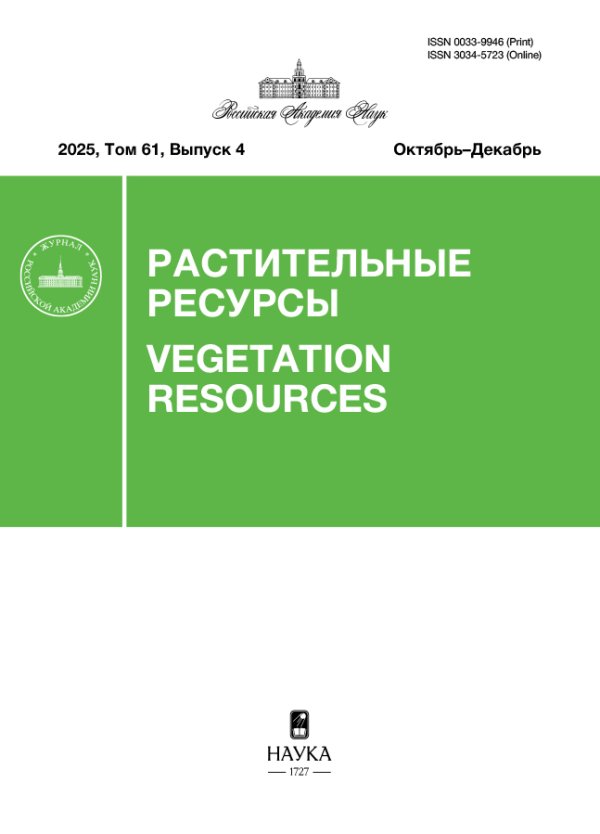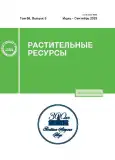Phytochemical Features of Malabaila dasyantha (Apiaceae) Aerial Parts
- Authors: Mammadova H.G.1
-
Affiliations:
- Department of Chemistry and Biology, Sumgait State University
- Issue: Vol 59, No 3 (2023)
- Pages: 321-326
- Section: Component Composition of Resource Species
- URL: https://journals.rcsi.science/0033-9946/article/view/138808
- DOI: https://doi.org/10.31857/S0033994623030032
- EDN: https://elibrary.ru/RSYDPM
- ID: 138808
Cite item
Full Text
Abstract
Malabaila dasyantha (C. Koch) Grossh (Apiaceae) is one of the species widely used in folk medicine. However, scientific research of this species has not been carried out, and almost no information on it is found in academic scientific databases. The new distribution areas of M. dasyantha were discovered in Gadabay district, Azerbaijan. It was determined that the plant belongs to the xerophytic ecological group. The chemical composition of the species was studied, focusing on the isolation and elucidation of phytochemical structures. The aerial parts of Malabaila dasyantha were finely cut and dried at ambient conditions. The mixture of extractive substances was obtained through three consecutive extractions with acetone, each 3 days long. The resulting acetone was filtered and evaporated on a water bath, resulting in a yellow resin with a 7% yield. The resin was then dissolved in CHCl3 and chromatographed over a column of neutral Al2O3 with elution by hexane, hexane + benzene, benzene, benzene + chloroform, chloroform, and chloroform + ethanol, in different ratios. Each fraction had a volume of 100 mL, and the separation and isolation process was carried out using column (silica gel) and thin-layer chromatographic methods. The structural elucidation of the purified compounds was based on infrared spectroscopy, ultraviolet, 1H and 13C-NMR data, and compared with those previously reported in the literature. The isolated compounds from the acetone extracts of M. dasyantha were identified as scopoletin (4.3%), oxypencedanin (2.6%), isoimperatorin (3.5%), and columbianetin (2.5%). These findings may have potential applications in the fields of medicine and pharmacology. Further studies are needed to fully explore the potential of these compounds and their therapeutic properties.
About the authors
Husniya Gara Mammadova
Department of Chemistry and Biology, Sumgait State University
Author for correspondence.
Email: husniyamammadova63@gmail.com
Azerbaijan, Sumgait City
References
- Ömer Kiliç. 2014. A morphological study on endemic Malabaila lasiocarpa Boiss. (Apiaceae) from Bingol (Turkey). – Bilecik Şeyh Edebali Üniversitesi Fen Bilimleri Dergisi. 1(1): 28–32. https://dergipark.org.tr/tr/pub/bseufbd/issue/22290/239069
- Stevens P.F. 2001 onwards. Angiosperm Phylogeny Website. Version 14, July 2017. http://www.mobot.org/MOBOT/research/APweb/ (Accessed 16.06.2023)
- Ibadullayeva S.C. 2004. [Apiaceae of the Azerbaijan flora.] Baku. 347p.
- Malabaila. The Plant List (2013). Version 1.1. http://www.theplantlist.org/1.1/browse/A/Apiaceae/Malabaila/
- Judd W.S., Campbell C.C., Kellogg E.A., Stevens P.F., Donoghue M.J. 2007. Plant systematics: A phylogenetic approach, 3rd edition. Sunderland. 611 p. https://www.cabdirect.org/cabdirect/abstract/20073241649
- Askerov A.M. 2016. [The higher plants of Azerbaijan (Conspectus of Azerbaijan flora)]. Vol. II. Baku. 283 p. (In Russian)
- Nassar M.I., Aboutabl E.A., Maklad Y.A., El-Khrisy E.D.A., Osman A.F. 2009. Chemical constituents and bioactivities of Malabaila suaveolens. — Phcog. Res. 1(6): 342–347. https://www.phcogres.com/article/2009/1/6/nil-1
- Zernov A.S. 2010. Plants of the Russian Western Caucasus. Field Atlas. Moscow. P. 447–448. (In Russian)
- Serkerov S.V., Aleskerova A.N. 2006. [Infrared spectra and structure of sesquiterpene lactones and coumarins]. Baku. 233p. (In Russian)
- Erbay M.S., Sarı A. 2018. Plants used in traditional treatment against hemorrhoids in Turkey. — Marmara Pharm. J. 22(2): 110–132. https://doi.org/10.12991/mpj.2018.49
- Mammadov T.S., Asadov H.H. 2014. [Plant ecology]. Baku. P. 296–300. (In Russian)
- Ghazanfar S.A. 1994. Handbook of Arabian Medicinal Plants. Boca Raton. 265 p.
Supplementary files















